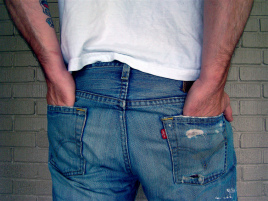Jeans, especially blue jeans, have been popular in the fashion world for decades. Since the teenage greaser culture of the 1950s, the ’60s hippies are into the ’70s and ’80s youth subculture of punk and metal, jeans have been a staple in everyone’s daily wardrobe.
Brands such as Lee’s, Wrangler and the historic Levi Strauss’s have been producing jeans since the 1800s yet keep them fresh with the changing trends and fads. Jeans can pull together the classic white t-shirt look, as well as any outfit ranging from classy to casual dress.
Thirty-nine percent of the global consumption of jeans comes from North America alone, and even though yoga pants and other activewear have been taking over the market, jeans are a fundamental fashion basic for everyday use.
Most of us have experienced the perks and horrors of the bootleg cut in our childhood, somewhat gracefully transitioned to straight leg or skinny jeans and occasionally try out boyfriend jeans or the mom jean style, and the one thing that has remained consistent is the material. Denim.
Denim, while not the only fabric used for jeans, should be the only acceptable material for jeans and, in reality, for any other type of clothing. Denim epitomizes American clothing, as its popularity can be traced to a man in Nevada creating the first pair of rivet-reinforced denim pants in 1873.
The rest is history. Now denim is used for all different types of clothing, from jeans and skirts, to overalls and jackets. Denim is common to wear for casual Fridays at work or to fundraise for issues, such as the Lee National Denim Day, created by Lee Jeans to support women’s cancer programs, and Denim Day, where people wear jeans to raise awareness of rape and sexual assault. Artists have even taken up the material for a medium, including Sweden-based artist Denimu — who makes artwork only using denim by reusing jeans to create portraits and urban landscapes.
What makes denim even better is its connotation in the fashion world. Jeans were originally designed to be men’s work pants, but western women who worked alongside men on the ranches eventually began to wear the men’s jeans. In the 1930s Vogue had advertisements depicting a “western chic” style with women in tight-fitting jeans, and it was in the 1960s that manufacturers began to accommodate for a women’s physique.
According to fashion history, jeans became a way for women to level off the effect between the sexes, wearing them as a sign of rebellion to sexism and later just adapting them for casual wear. Jeans have also been seen as a symbol of youth rebellion and counterculture. The 1950s saw movie star James Dean representing rebellious youth in blue jeans and leather biker jackets. In the 1960s, sewing patches and painting messages on the material was a way to protest against the establishment and be in solidarity with the working class, sewing patches and painting messages on the material. If that isn’t enough, there is a style of jean for everyone.
Bell-bottoms in the ’70s, baggy jeans of the ’90s hip hop and skater subculture, distressed jeans (which are sold for way too much money), tight-fitting jeans to show off that nice body and of course the range from low-rise to high-rise jeans.
So why, one might ask, did I just spend the last 500 words describing the history and array of jeans available? I really just love denim products. Ever since denim jackets came back into style, I never leave my apartment without an article of denim clothing on me. Someone once distinguished me from a crowd due to the apparently excessive (even though I deem it perfectly adequate) amount of denim on my person.
Denim on denim is not a crime — it’s a fashion statement. For every season, every weather condition and every color, denim is by far the ultimate clothing material. Next time you see someone on campus wearing blue jeans and a denim jacket, compliment them on a job well done. It will probably be me.





